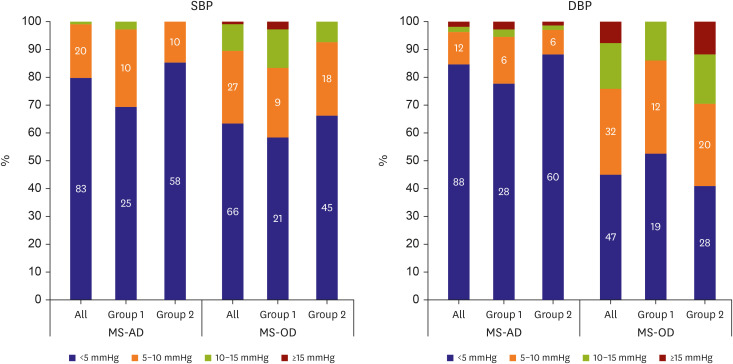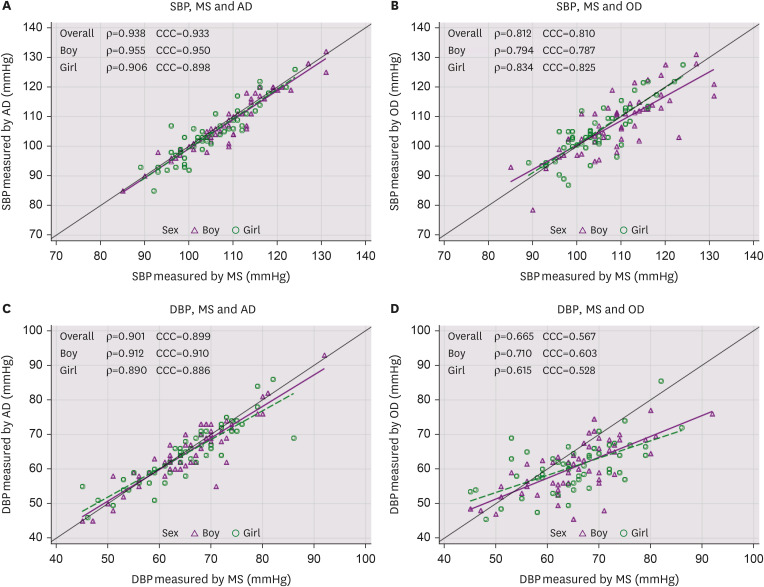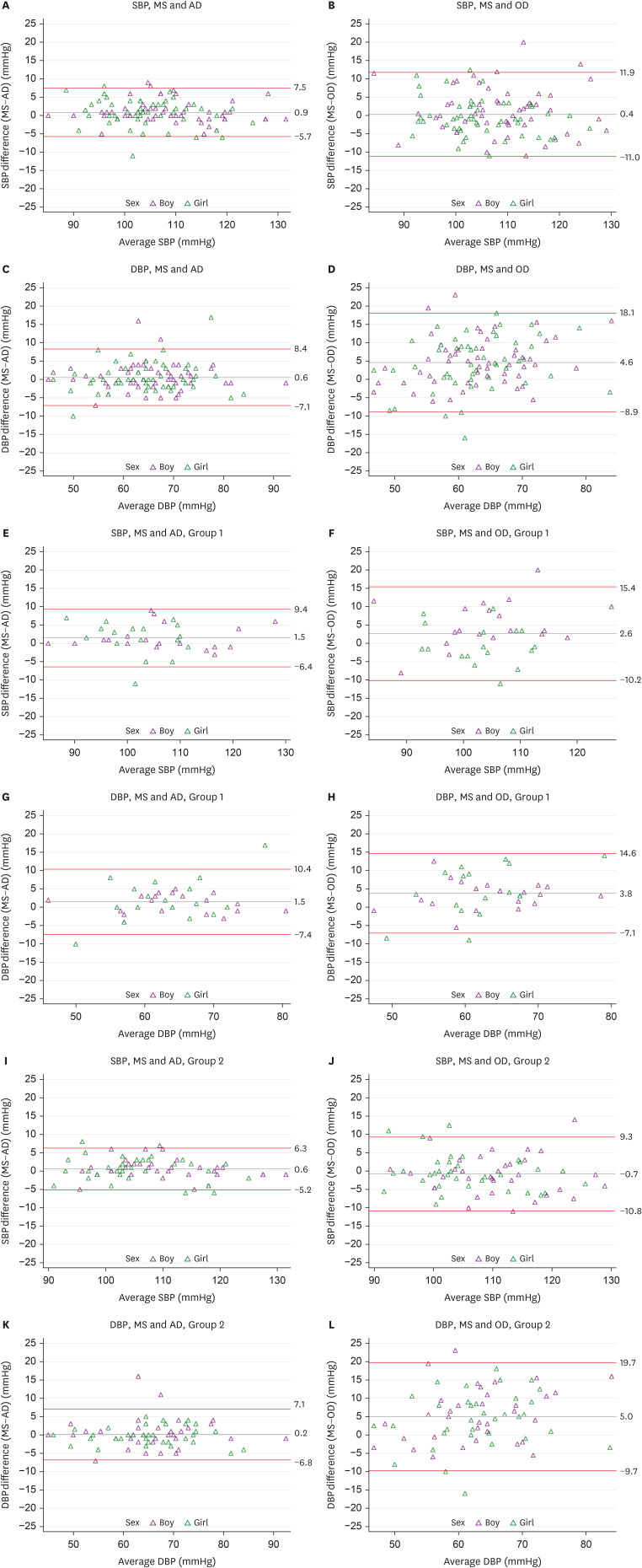Korean Circ J.
2024 May;54(5):270-287. 10.4070/kcj.2023.0274.
Replacing Mercury Sphygmomanometers With Mercury-Free Sphygmomanometers for the National Health Survey in Children: Direct Comparisons Applying Two Types of Mercury-Free Sphygmomanometer
- Affiliations
-
- 1Department of Pediatrics, CHA Bundang Medical Center, CHA University, Seongnam, Korea
- 2Department of Preventive Medicine, Hanyang University College of Medicine, Seoul, Korea
- 3Graduate School of Public Health, Hanyang University, Seoul, Korea
- 4Department of Pediatrics, Seoul National University Children’s Hospital and Seoul National University College of Medicine, Seoul, Korea
- 5Division of Cardiology, Department of Internal Medicine, Hanyang University College of Medicine, Seoul, Korea
- 6Division of Cardiology, Department of Internal Medicine, Wonkwang University Sanbon Hospital, Gunpo, Korea
- KMID: 2556524
- DOI: http://doi.org/10.4070/kcj.2023.0274
Abstract
- Background and Objectives
Blood pressure (BP) measurement using an auscultatory sphygmomanometer is recommended for diagnosing hypertension in children. As mercury sphygmomanometers (MSs) are banned owing to environmental concerns, it is crucial to determine the accuracy of mercury-free sphygmomanometers to replace them. We analyzed the accuracy of these devices to guide the National Survey selection.
Methods
BP was measured thrice each with MS, auscultatory device (AD), and oscillometric device (OD) in 104 participants aged 10–18 using the National Survey data. The difference in BP was defined as the difference between MS and other devices. The BP differences, correlations, and influencing factors were analyzed. The frequencies of hypertension were also compared.
Results
Systolic BP (SBP) and diastolic BP (DBP) differences between MS and AD were 0.88±3.36 mmHg and 0.63±3.95 mmHg, and those between MS and OD were 0.43±5.83 mmHg and 4.57±6.89 mmHg, respectively. The absolute error of <10 mmHg for DBP between MS and OD was 76%. The concordance correlation coefficient between MS and AD was 0.94 for SBP and 0.90 for DBP, and 0.81 and 0.67, respectively for MS and OD. Arm circumference negatively correlated with BP differences except for SBP between the MS and OD. The frequency of hypertension was not different between MS and AD but was underestimated by OD.
Conclusions
AD correlated well with MS, while OD did not, especially for DBP. The superiority of AD over OD suggests AD as a possible alternative for MS in the National Survey.
Keyword
Figure
Reference
-
1. Flynn J. The changing face of pediatric hypertension in the era of the childhood obesity epidemic. Pediatr Nephrol. 2013; 28:1059–1066. PMID: 23138756.2. Song P, Zhang Y, Yu J, et al. Global prevalence of hypertension in children: a systematic review and meta-analysis. JAMA Pediatr. 2019; 173:1154–1163. PMID: 31589252.3. Vos LE, Oren A, Uiterwaal C, Gorissen WH, Grobbee DE, Bots ML. Adolescent blood pressure and blood pressure tracking into young adulthood are related to subclinical atherosclerosis: the Atherosclerosis Risk in Young Adults (ARYA) study. Am J Hypertens. 2003; 16:549–555. PMID: 12850388.4. Juhola J, Magnussen CG, Viikari JS, et al. Tracking of serum lipid levels, blood pressure, and body mass index from childhood to adulthood: the Cardiovascular Risk in Young Finns Study. J Pediatr. 2011; 159:584–590. PMID: 21514597.5. Theodore RF, Broadbent J, Nagin D, et al. Childhood to early-midlife systolic blood pressure trajectories: early-life predictors, effect modifiers, and adult cardiovascular outcomes. Hypertension. 2015; 66:1108–1115. PMID: 26558818.6. Kim DH, Cho IJ, Kim W, et al. Elevated on-treatment diastolic blood pressure and cardiovascular outcomes in the presence of achieved systolic blood pressure targets. Korean Circ J. 2022; 52:460–474. PMID: 35388992.7. Cho JY, Cho DH, Youn JC, et al. Korean Society of Heart Failure guidelines for the management of heart failure: definition and diagnosis. Korean Circ J. 2023; 53:195–216. PMID: 37161680.8. Flynn JT, Kaelber DC, Baker-Smith CM, et al. Clinical practice guideline for screening and management of high blood pressure in children and adolescents. Pediatrics. 2017; 140:e20171904. PMID: 28827377.9. Lurbe E, Agabiti-Rosei E, Cruickshank JK, et al. 2016 European Society of Hypertension guidelines for the management of high blood pressure in children and adolescents. J Hypertens. 2016; 34:1887–1920. PMID: 27467768.10. National High Blood Pressure Education Program Working Group on High Blood Pressure in Children and Adolescents. The fourth report on the diagnosis, evaluation, and treatment of high blood pressure in children and adolescents. Pediatrics. 2004; 114:555–576. PMID: 15286277.11. Minamata Convention on Mercury - text and annexes. UN environment 362 programme [Internet]. Chatelaine: Minamata Convention on Mercury;2013. cited 2015 March 15. Available from: https://minamataconvention.org/en/documents/minamata-convention-mercury-text-and-annexes.12. Choi S, Kim YM, Shin J, et al. Comparison of the accuracy and errors of blood pressure measured by 2 types of non-mercury sphygmomanometers in an epidemiological survey. Medicine (Baltimore). 2018; 97:e10851. PMID: 29923975.13. Kim YM, Ohn DW, Kim SH, et al. Direct comparison of an automated oscillometric device with an electronic auscultatory device for epidemiologic survey to evaluate the prevalence of hypertension. Medicine (Baltimore). 2022; 101:e32299. PMID: 36550921.14. Association for the Advancement of Medical Instrumentation (AAMI). American National Standards for Electronic or Automated Sphygmomanometers. Arlington (VA): AAMI;2002.15. Stergiou GS, Alpert B, Mieke S, et al. A universal standard for the validation of blood pressure measuring devices: Association for the Advancement of Medical Instrumentation/European Society of Hypertension/International Organization for Standardization (AAMI/ESH/ISO) collaboration statement. J Hypertens. 2018; 36:472–478. PMID: 29384983.16. Graves JW, Tibor M, Murtagh B, Klein L, Sheps SG. The Accoson Greenlight 300, the first non-automated mercury-free blood pressure measurement device to pass the International Protocol for blood pressure measuring devices in adults. Blood Press Monit. 2004; 9:13–17. PMID: 15021073.17. El Assaad MA, Topouchian JA, Darné BM, Asmar RG. Validation of the Omron HEM-907 device for blood pressure measurement. Blood Press Monit. 2002; 7:237–241. PMID: 12198340.18. O’Brien E, Petrie J, Littler W, et al. An outline of the revised British Hypertension Society protocol for the evaluation of blood pressure measuring devices. J Hypertens. 1993; 11:677–679. PMID: 8397248.19. Lee EM, Kim Y, Kim SH, Sung K, Ihm S, Shin J. Quality Control and Assurance of Blood Pressure Measurement: Korea National Health and Nutrition Examination Survey 2019. Sejong: Korea Centers for Disease Control and Prevention;2021.20. Kim HL, Park SM, Cho IJ, et al. Standardized protocol of blood pressure measurement and quality control program for the Korea National Health and Nutrition Examination Survey. Clin Hypertens. 2023; 29:28. PMID: 37821979.21. American National Standards Institute (ANSI). Non-invasive sphygmomanometers - part 2: clinical investigation of automated measurement type. ANSI/AAMI/ISO 81060-2. New York (NY): ANSI;2013. cited 2017 July. Available from: http://webstore.ansi.org.22. Kim SH, Park Y, Song YH, et al. Blood pressure reference values for normal weight Korean children and adolescents: data from The Korea National Health and Nutrition Examination Survey 1998-2016: The Korean Working Group of Pediatric Hypertension. Korean Circ J. 2019; 49:1167–1180. PMID: 31456368.23. Ostchega Y, Nwankwo T, Sorlie PD, Wolz M, Zipf G. Assessing the validity of the Omron HEM-907XL oscillometric blood pressure measurement device in a National Survey environment. J Clin Hypertens (Greenwich). 2010; 12:22–28. PMID: 20047626.24. Ostchega Y, Prineas RJ, Nwankwo T, Zipf G. Assessing blood pressure accuracy of an aneroid sphygmomanometer in a national survey environment. Am J Hypertens. 2011; 24:322–327. PMID: 21164495.25. Duncombe SL, Voss C, Harris KC. Oscillometric and auscultatory blood pressure measurement methods in children: a systematic review and meta-analysis. J Hypertens. 2017; 35:213–224. PMID: 27870656.26. Araujo-Moura K, Souza LG, Mello GL, De Moraes AC. Blood pressure measurement in pediatric population: comparison between automated oscillometric devices and mercury sphygmomanometers-a systematic review and meta-analysis. Eur J Pediatr. 2022; 181:9–22. PMID: 34272985.27. Ostchega Y, Hughes JP, Kit B, et al. Differences in Hypertension and stage ii hypertension by demographic and risk factors, obtained by two different protocols in US adults: National Health and Nutrition Examination Survey, 2017-2018. Am J Hypertens. 2022; 35:619–626. PMID: 35333925.
- Full Text Links
- Actions
-
Cited
- CITED
-
- Close
- Share
- Similar articles
-
- Evaluation of the DINAMAP 8100 Automated Blood Pressure monitor: comparison with the Mercury Sphygmomanometer
- Aneroid Auscultatory Sphygmomanometers and Automated Oscillometric Devices as Mercury-Free Alternatives in Children
- Time for Young Adults to Reach Resting Blood Pressure after Walking as measured by an Automatic and a Mercury Sphygmomanometer
- Global Trends in Mercury Management
- Clinical Evaluation of the Accuracy of Electronic Home Blood Pressure Measuring Devices




